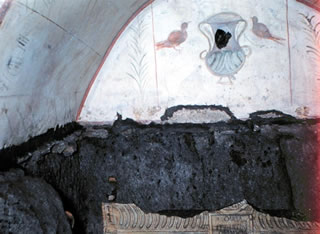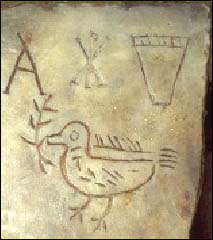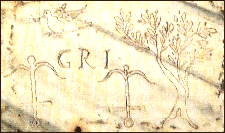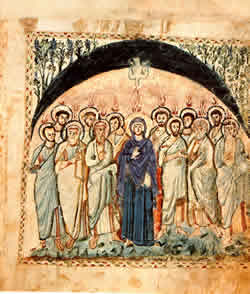
|
The Descent of a Dove and the Peace of Pentecost
For Sunday May 31, 2009
Lectionary Readings (Revised Common Lectionary, Year B))
Acts 2:1–21 or Ezekiel 37:1–14
Psalm 104:24–34, 35b
Romans 8:22–27 or Acts 2:1–21
John 15:26–27; 16:4b–15
 |
Catacomb fresco of two doves, vase, palm branches. |
I once told a friend who's a film expert that when I watch a movie, I listen for a single sentence or short dialogue that captures the entire film. "I do the same thing," said Scott, "but I look for an image that summarizes the movie." Christians identify themselves as people of the Book who worship the Word made flesh. It took a while, but Christians also became people of images, and in those images they expressed their faith as much as they did in words.
In the marvelous book Picturing the Bible: The Earliest Christian Art (2007), Jeffrey Spier explains how the early Jesus movement first expressed itself in visual forms. Art and architecture flourished in classical Greece and Rome, of course, but "the Christians were slow to express their religious beliefs pictorially, and no churches, decorated tombs, nor indeed Christian works of art of any kind datable before the third century are known." This might have been because the earliest Christians were a persecuted and illicit sect comprised largely of people from lower socio-economic classes. They also inherited Judaism's ambivalence toward art rooted in the prohibition against graven images in Exodus 20:4.
 |
Around the year 200, says Spier, "purely Christian images began to appear." The forty catacombs in and around Rome, along with the discovery of a house church at Dura Europos in Syria dated to 240 AD, show how the earliest Christian art was not merely decorative but intentionally devotional; its purpose was not "objective beauty" but an "expression of faith." In the first decades of the third century, genuine Christian art appears on seal rings, tombs, clay lamps, engraved gems, and in one instance a marble statuette. A hundred years after that, Christian art adorns belt buckles and Bible covers, plates and coins, intricate mosaics and ornate crosses (see Spier, pp. 1–23).
Just as Christians portrayed Jesus as a shepherd, fish, anchor, or a lamb, the five images in this essay illustrate how the Holy Spirit was represented by a dove. The symbolism of the dove hearkens back to when Noah sent a dove out from the ark to see if the flood waters had receded. When the dove returned, "there in its beak was a freshly plucked olive leaf" (Genesis 8:11). Peace and safety at last for all humanity! In all three synoptic gospels, when John baptized Jesus, the Spirit descended upon him as a dove (Matthew 3:16 = Mark 1:10 = Luke 3:22). The illuminated Rabbula Gospel from the sixth century, like thousands of similar images thereafter, reminds us that Pentecost celebrates the descent of the dove and the peace of the Spirit into our own lives today.
 |
The earliest Christian writers didn't say much about art and images, and Spier believes that their hostility toward visual representations has been exaggerated. Most of early Christian art drew upon well-known Bible texts like Noah, Daniel in the lion's den, Moses, Jonah, Adam and Eve, and Abraham. In perhaps the earliest textual reference to Christian art, Clement of Alexandria (150–215) writes that Christians could also borrow pagan symbols as long as they were appropriate. Swords and bows would be inappropriate, he said, because they signaled war and violence, but a dove was suitable, said Clement, "since we follow peace."
 |
Truly "pentecostal" believers are people of peace and the descent of the dove. "Seek peace and pursue it," wrote the ancient psalmist (Psalm 34:14). "Make every effort to live in peace with all people," says Hebrews 12:14. "Make every effort to do what leads to peace," wrote Paul to the Romans (Romans 14:19). As followers of the Prince of Peace (Isaiah 9:6) and the "Lord of peace," we wish every person "peace at all times and in every way" (1 Thessalonians 3:16). "Blessed are the peacemakers," said Jesus (Matthew 5:9).
There's a fascinating commentary about the work of the Spirit in the life of Israel's first king, Saul. We read in 1 Samuel 10:6 that when the Spirit of the Lord came upon Saul, “he was changed into another person." This Pentecost I'm praying the Peace Prayer ascribed to Saint Francis of Assisi (1182–1226). It captures the sort of radical change into "another sort of person" for which I pray:
Lord, make me an instrument of your peace.
Where there is hatred, let me sow love;
Where there is error, truth;
Where there is injury, pardon;
Where there is doubt, faith;
Where there is despair, hope;
Where there is darkness, light;
And where there is sadness, joy.O Divine Master, grant that I may not so much seek
To be consoled as to console;
To be understood as to understand;
To be loved as to love.For it is in giving that we receive;
It is in pardoning that we are pardoned;
It is in self-forgetting that we find;
And it is in dying to ourselves that we are born to eternal life.
Amen.
We don't know the actual author of this famous prayer, and it was not until the 1920s that it was even ascribed to Saint Francis. By one account the prayer was found in 1915 in Normandy, written on the back of a card of Saint Francis. But it certainly expresses his longing to be an instrument of peace in our violent world.
 |
Pentecost, the Rabbula Gospel, c. 586, illuminated Syriac Bible, |
In the Old Testament, the Hebrew word for "spirit" (ruach) means breath or wind. The very first sentences of the Bible describe God's Spirit hovering over all creation like a tender mother (Genesis 1:2). In the New Testament, the Spirit is called the paraclete, literally, one called alongside to help, an encourager, comforter or counselor. And in the earliest art of the first believers, the Spirit is a dove of peace descending into our lives to bring the presence of God's shalom, that is, anything and everything that nourishes human wholeness and well-being.
Image credits: (1) Yale Divinity Digital Image & Text Library; (2–4) JesusWalk.com; and (5) Wikimedia.org.





